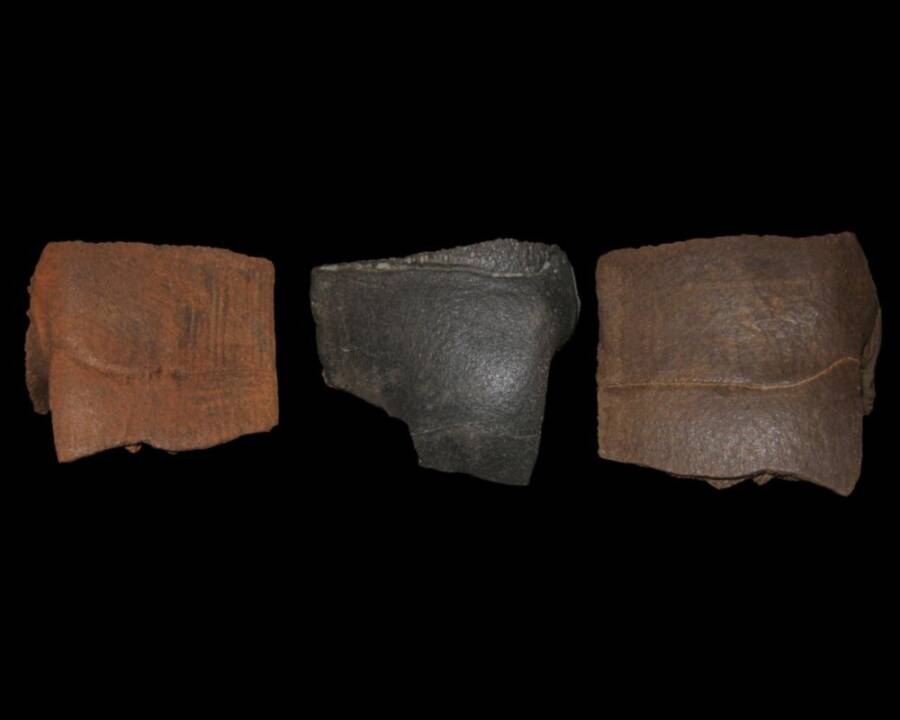Archaeologists analyzing turtle shell fragments found near Magdeburg, Germany, believe they may have been carried to the area by Ice Age hunters as a living food source.

Uwe Beye/State Office for Monument Preservation and Archaeology Saxony-AnhaltThree of the European pond turtle shell fragments found in Germany.
Archaeologists in Magdeburg, Germany, recently discovered fragments of European pond turtle shells in a gravel quarry, and now they’re trying to determine how they got there.
Researchers used radiocarbon dating to determine the shells are between 42,000 and 50,000 years old. This places them in a time period when Germany was covered in ice, making it unlikely that the creatures lived and bred in the area.
Instead, scientists have posited that Ice Age hunters may have carried the turtles with them from warmer southern regions as “living tins” of food.
The Ice Age Turtle Shells Discovered In A German Gravel Pit
The Barleben-Adamsee gravel pit near Magdeburg, Germany, has long been a trove of ancient artifacts. In fact, there is so much history hidden in the stone that workers at the rock quarry often pull prehistoric items off the conveyor belt used for processing the gravel.
Because gravel is extracted from beneath the water using bucket dredgers, researchers cannot test specific levels of sediment. Therefore, they rely on radiocarbon dating and comparing the shapes of objects with similar finds elsewhere.
Over the years, more than 180 flint artifacts have been recovered from the quarry, including axes and other tools. A carved bison rib was also pulled from the pit that that is one of the oldest bone tools ever found in central Germany.
Now, archaeologists have discovered five fragments of European pond turtle shell in the gravel pit, as described in a press release from the Saxony-Anhalt State Office for Monument Preservation and Archaeology. What’s more, researchers believe these shells are evidence that Ice Age humans carried turtles with them as a live meat source.
Did Ice Age Europeans Use Turtles As “Living Tins” Of Food?
Researchers studied the five turtle shell fragments found at the quarry using radiocarbon dating and determined that they’re between 42,000 and 50,000 years old.

Uwe Beye/State Office for Monument Preservation and Archaeology Saxony-AnhaltThe Barleben-Adamsee gravel pit where researchers discovered the turtle shell fragments.
The problem is that European pond turtles (Emys orbicularis) don’t incubate eggs in temperatures lower than 64 degrees Fahrenheit, and 50,000 years ago, Germany was covered in ice. This means that the shells belonged to turtles that likely weren’t living and breeding in the area at the time.
Experts have posited that Ice Age hunters carried the turtles to the region with them as “living tins” of food, as they were an easily transportable source of meat. Other cultures throughout history are known to have used turtles in a similar manner.
Unlike other artifacts found at the quarry, experts are not sure if early modern humans or Neanderthals were responsible for bringing these turtle shells to the area. Further research will be necessary to determine this.
“The next step in researching the turtle shells would indeed be to get a clearer image of where they are coming from. There is a variety of methods that could be applied here. For example, analysis of stable isotopes (Strontium) could generate new insights,” Dr. Oliver Dietrich, a public relations officer for the State Office for Monument Preservation and Archeology Saxony-Anhalt told All That’s Interesting in an email.
Until then, scientists are eagerly waiting to see what else the Barleben-Adamsee gravel pit reveals about our ancient past.
After reading about the Ice Age turtle shells discovered in Germany, dive into the stories of 11 unbelievable prehistoric animals. Then, learn about Ötzi the Iceman, the oldest preserved human being ever discovered.






